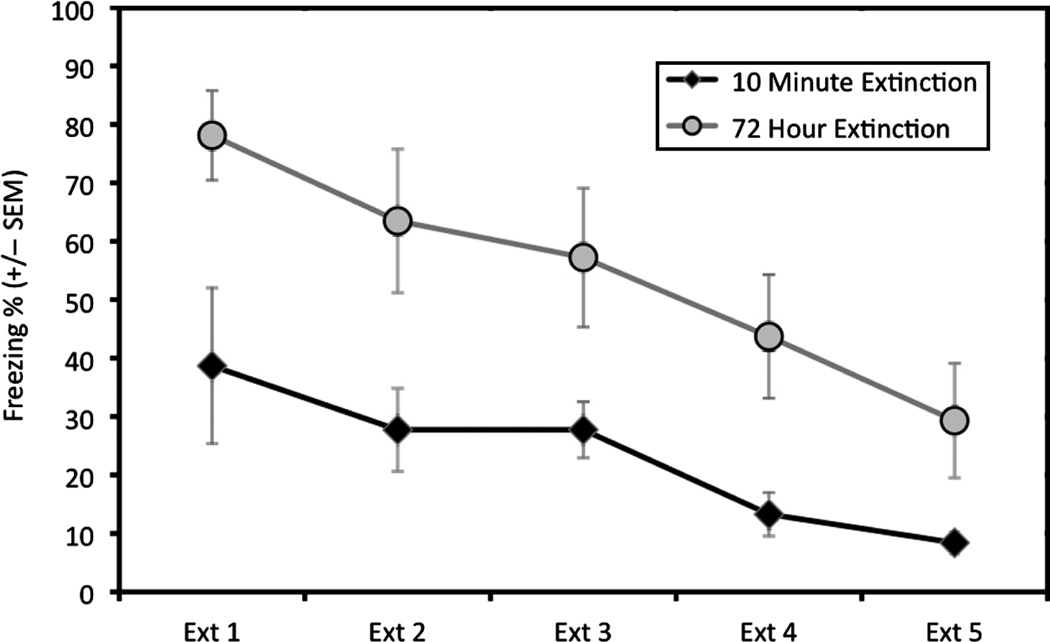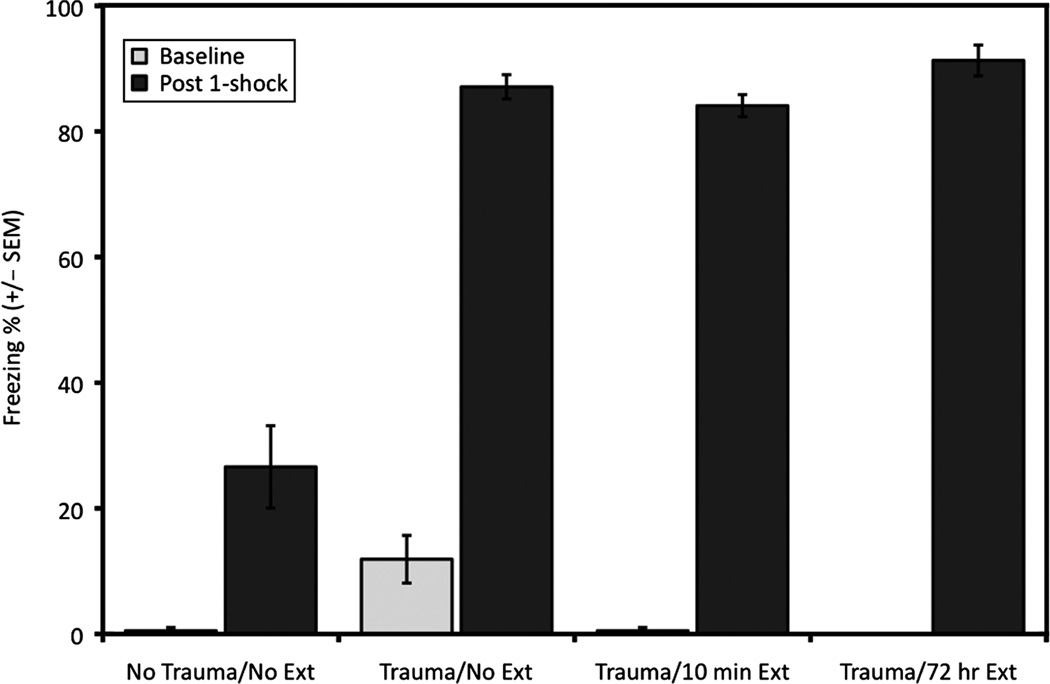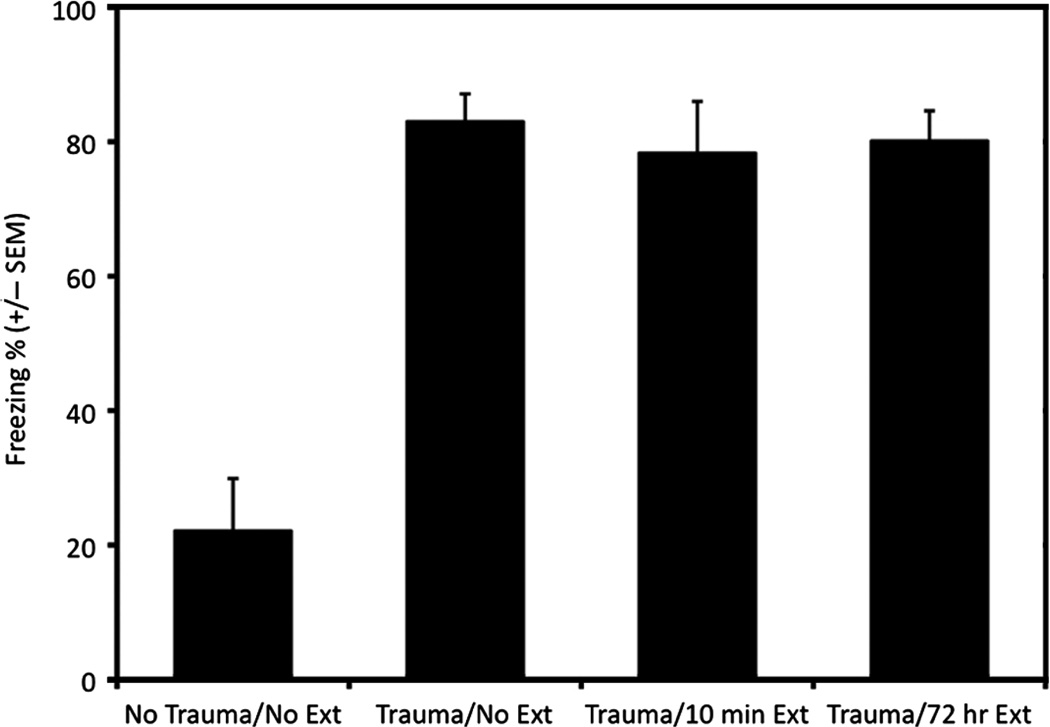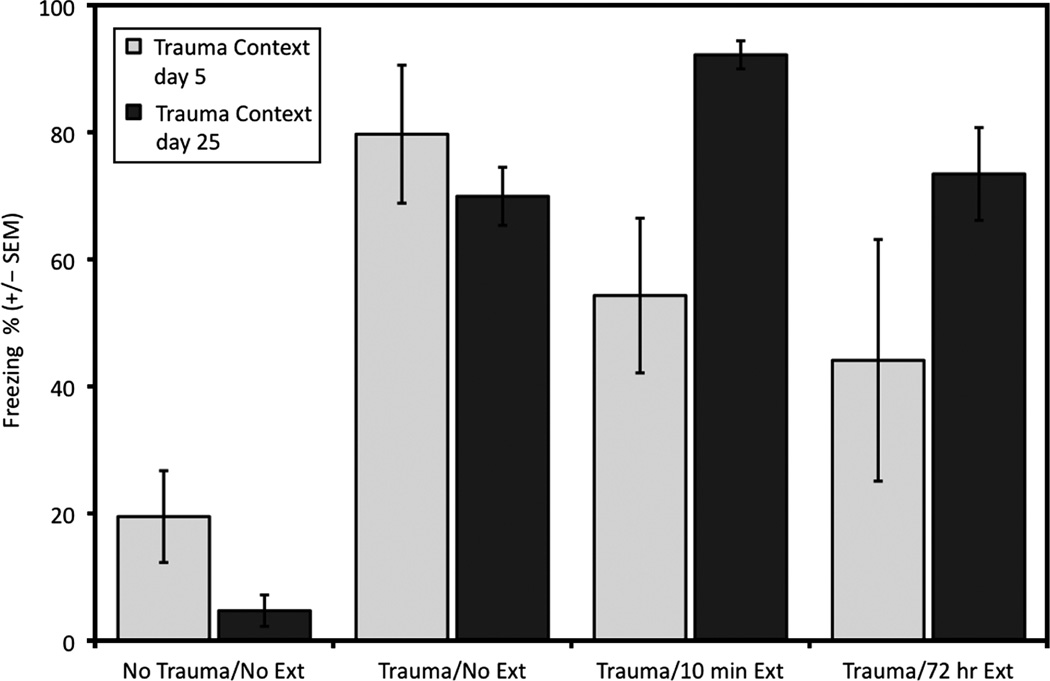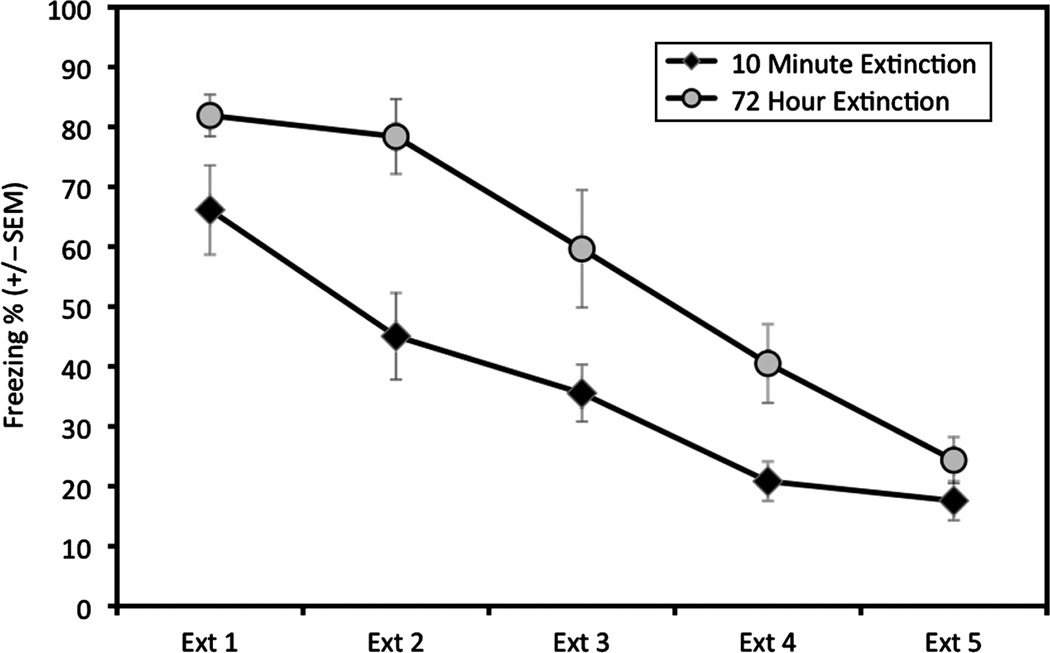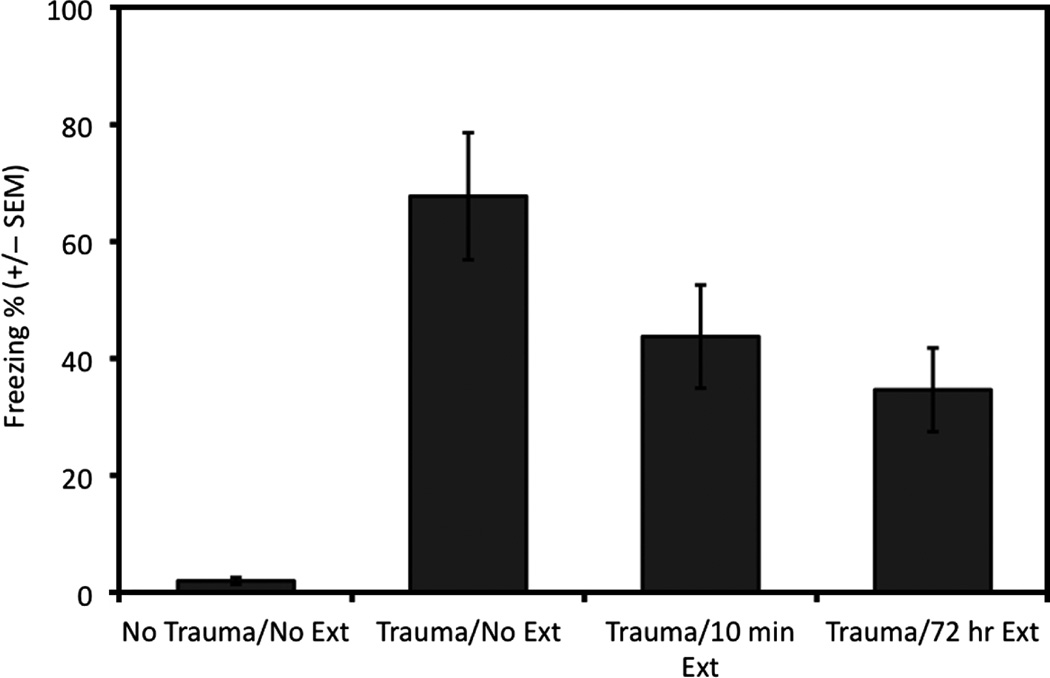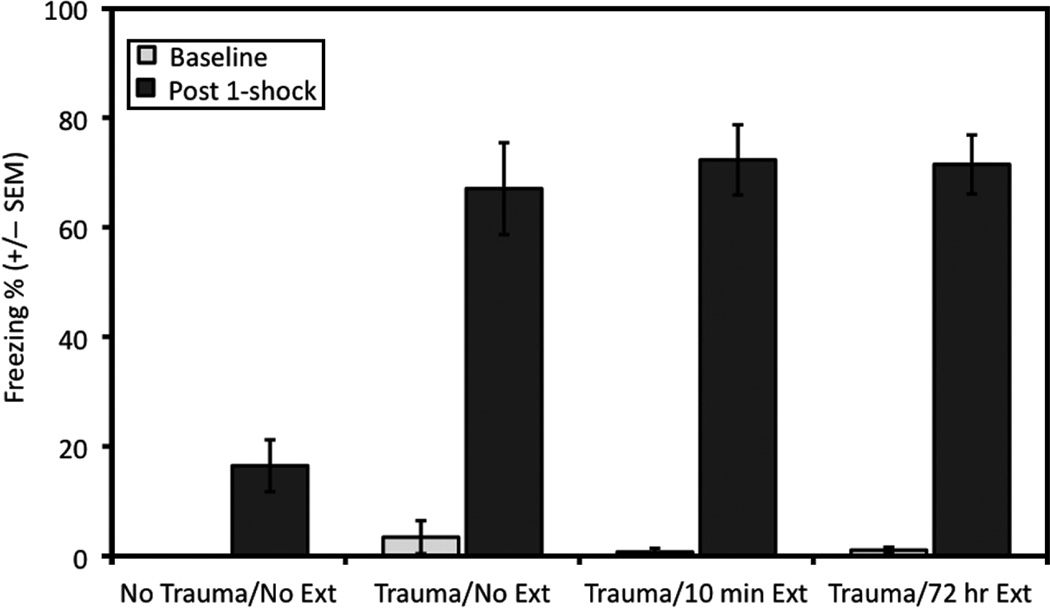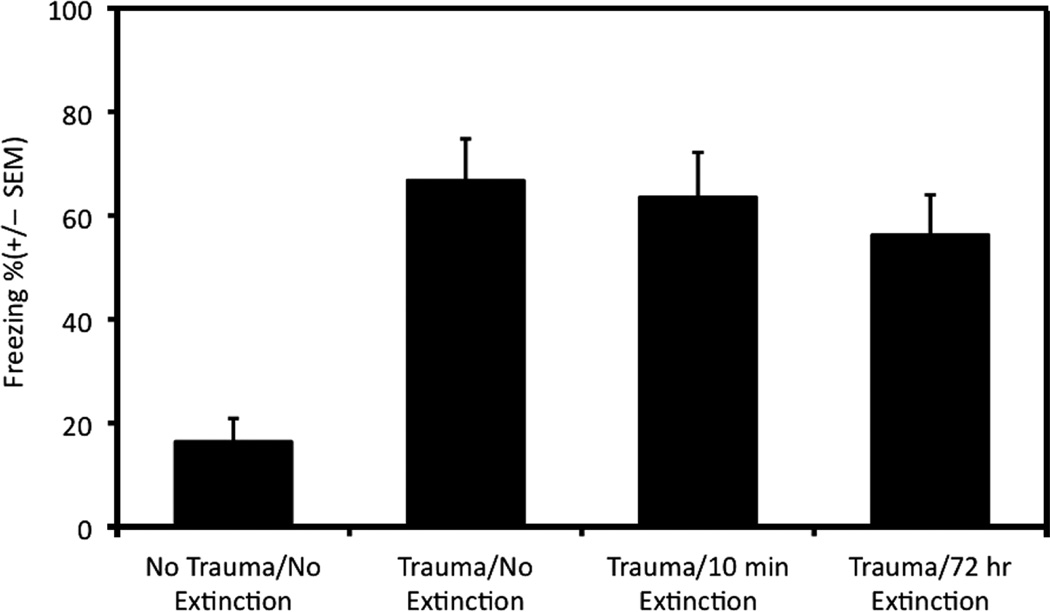Abstract
Enhanced fear learning occurs subsequent to traumatic or stressful events and is a persistent challenge to the treatment of post-traumatic stress disorder (PTSD). Facilitation of learning produced by prior stress can elicit an exaggerated fear response to a minimally aversive event or stimulus. Stress-enhanced fear learning (SEFL) is a rat model of PTSD; rats previously exposed to the SEFL 15 electrical shocks procedure exhibit several behavioral responses similar to those seen in patients with PTSD. However, past reports found that SEFL is not mitigated by extinction (a model of exposure therapy) when the spaced extinction began 24 h after stress. Recent studies found that extinction from 10 min to 1 h subsequent to fear conditioning “erased” learning, whereas later extinction, occurring from 24 to 72 h after conditioning did not. Other studies indicate that massed extinction is more effective than spaced procedures. Therefore, we examined the time-dependent nature of extinction on the stress-induced enhancement of fear learning using a massed trial’s procedure. Experimental rats received 15 foot shocks and were given either no extinction or massed extinction 10 min or 72 h later. Our present data indicate that SEFL, following traumatic stress, is resistant to immediate massed extinction. Experimental rats showed exaggerated new fear learning regardless of when extinction training occurred. Thus, post-traumatic reactivity such as SEFL does not seem responsive to extinction treatments.
Keywords: Acute stress, fear extinction, fear learning and memory, foot shock, immediate extinction, post-traumatic stress disorder
Introduction
In post-traumatic stress disorder (PTSD) as well as other anxiety disorders, normally adaptive fear responses become dysfunctional or maladaptive (Rosen and Schulkin 1998; Charney 2004) when behavioral responses are no longer commensurate with appropriate fear for the situation, or when behavior disrupts normal daily functioning. The various symptoms required for the clinical diagnosis of anxiety disorders such as PTSD are increased physiological arousal, hypervigilance, and heightened startle response (American Psychiatric Association 2000). These symptoms may be manifested as an exaggerated behavioral response to an event or stimulus that serves as a reminder of the original trauma. An important clinically relevant consequence of prior trauma is when inappropriate behavioral responses to mildly aversive or fear generating situations translate into the formation of new phobias (Goisman et al. 1998). Enhanced fear learning subsequent to trauma is a long-lasting effect (Rau and Fanselow 2009) that may also be a factor complicating treatment for PTSD.
Resistance to extinction treatment is one of the many challenges to the treatment of PTSD. Often behavioral (exposure) therapy is not entirely effective in eliminating symptoms such as exaggerated responses to milder reminder stimuli (Craske et al. 2008). Extinction procedures, typically spaced over a period of days, are usually regarded as a form of inhibitory learning that occurs when a conditional stimulus (CS) and an unconditional stimulus (US) are presented in a manner such that the CS no longer signals that the US will occur, and is regarded as an analogous procedure in animals to human behavioral treatments of anxiety disorders (Hermans et al. 2006).
Although extinction training is often spaced over several days, some recent findings indicate that the massed presentation of the CS initiates the process of extinction successfully, and that massed procedures produce fear extinction that is effective for both short- and long-term reduction in fear response (Cain et al. 2003). However, more recently the long-term efficacy of massed extinction has been challenged and some laboratories have observed weaker suppression of fear (Maren and Chang 2006; Li and Westbrook 2008). Nonetheless, one of the advantages that massed extinction procedures offer is temporal efficiency; hence, extinction procedures can be performed in a single extinction session.
Extinction is generally agreed to be a process of new learning that does not abolish previous learning, but rather reduces the response based on initial learning (Pavlov and Anrep 1927; Bouton 2004). However, it has been argued that there is a time-dependent quality to extinction such that different neural mechanisms may be at work if extinction training occurs immediately following fear conditioning. In a series of experiments,Myers et al. (2006) manipulated the time interval between fear conditioning and extinction. Rats were conditioned using light-shock pairings then extinguished 10 min, 1 h, 24 h, or 72 h later.Myers et al. (2006) found that extinction procedures, which were begun from 10 min to 1 h after fear conditioning, produced an “unlearning” of fear rather than new inhibitory learning. Therefore,Myers et al. (2006) proposed that extinction that occurs immediately after fear learning can “erase” fear, while extinction that occurs 24 – 72 h later results in new learning. However, the efficacy of early (occurring soon after conditioning) extinction of fear has been controversial. A number of studies using rats as well as human subjects have examined early or immediate versus delayed extinction of fear conditioning. Several studies found that early extinction produces weak extinction that does not produce long-lasting suppression of fear (Maren and Chang 2006; Woods and Bouton 2008; Chang and Maren 2009), and even when early extinction occurred, it was found to be less effective at reducing long-term fear as measured by the spontaneous recovery of fear, and did not show evidence for erasure of fear (Schiller et al. 2008; Huff et al. 2009).
Stress-enhanced fear learning (SEFL) is an animal model of PTSD, developed byRau et al. (2005) to investigate the stress-induced enhancement of fear learning that occurs subsequent to traumatic or acutely stressful events. A traumatic/stressful event is simulated with 15 electrical foot shocks, at variably spaced intervals, over 90 min. In the SEFL procedure, foot shocks are both inescapable and unpredictable. Inescapable and unpredictable shock has been shown to be one method of producing heightened fear response to subsequent stimuli (Maier 1990; Baratta et al. 2007). Another unique aspect of the SEFL protocol is that foot shocks are not preceded by an explicit cue. This type of context conditioning may be more pertinent to PTSD because a traumatic event may take place under conditions where the trauma is not predicted or signaled by a specific and salient cue. Interestingly, stress-induced sensitization of context fear is proposed to be a possible explanation for the lack of efficacy of early extinction in reducing fear response (Maren and Chang 2006; Chang and Maren 2011).
Sensitization of fear learning as well as eye-blink conditioning has also been found to be enhanced in animals that previously received inescapable shock (Maier 1990; Shors et al. 1992). Similarly,Rau et al. (2005) found that animals exposed to the inescapable 15 shocks showed a significant increase in new fear learning after being exposed to a single shock in a novel environment. In contrast, control animals that did not receive the 15-shock treatment showed only moderate levels of fear when tested in the single-shock novel environment.
In the second experiment byRau et al. (2005), animals received the 15-shock procedure and were then extinguished in the trauma context for 5 sequential days by 30-min daily exposures to the trauma context. They found that the enhancement of later fear conditioned by a single shock was completely resistant to extinction treatment. While the conditional fear to the context in which the trauma took place was eliminated by extinction, the SEFL to a new context was equivalent in both the extinguished and non-extinguished rats, indicating that the fear response was not produced by the simple generalization of fear but rather that subsequent fear processing itself had been altered.
Previous work using the SEFL model employed a spaced extinction procedure that did not begin until one day after trauma. In light of the controversial findings regarding the efficacy of immediate and massed extinction in suppressing fear, as well as the possibility that stress-enhanced contextual fear conditioning may be differentially affected by manipulations such as immediate and massed extinction, the present study examined the effects of massed extinction that began immediately after the trauma on subsequent new fear learning as measured by SEFL. We used theRau et al. (2005) 15-shock SEFL procedure to induce enhanced fear learning. Massed extinction training occurred 10 min or 72 h subsequent to the traumatic stress. The massed extinction training consisted of five 30-min sessions spaced 5 min apart, allowing us to constrain the time between the trauma and the extinction to a specific post-stress interval. The timing of extinction relative to stress would not be possible using an extinction procedure distributed over days.
In Experiment 1, on the day following the 15-shock trauma, rats received a massed extinction procedure in the trauma context (after 10 min or 72 h); new fear learning was produced by a single shock in a novel environment and was measured the following day on a subsequent test of contextual fear memory of the novel environment. Group comparisons based on freezing scores, a measure of learned fear (Fanselow 1980; Fanselow and Lester 1988), were made among the no shock trauma group and the shocked trauma groups that received no extinction, immediate (10 min later), or delayed (72 h later) extinction. The relative long-term efficacy (measured by the spontaneous recovery of fear) in the two extinction conditions was assessed on either the 3rd or 23rd day after the extinction training in the original shock/extinction environment. We hypothesized that if the massed immediate extinction commencing 10 min after the 15-shock trauma produced erasure of the contextual fear memory then subsequently SEFL would not occur. Likewise, if rats received delayed extinction that does not induce erasure they would show SEFL similar to non-extinguished rats. Additionally, we hypothesized that if early 10-min extinction was effectively erasing trauma context fear learning then subsequent tests of spontaneous recovery should reveal lower levels of fear compared to rats that received delayed extinction.
In Experiment 2, we used a design similar to the design of Experiment 1. However, in order to address possible inadvertent effects that the single shock in the novel context may have produced on the expression of extinction learning, rats were placed back in the original shock/extinction environment for a contextual fear test 24 h following their massed extinction sessions on the day before receiving the single shock and the subsequent context test in the new environment. We hypothesized that testing the efficacy of the massed immediate versus delayed extinction before the SEFL inducing single shock would not alter enhanced fear learning; however, we would be able to observe the effect of the extinction treatments without confound.
Method
Subjects
Subjects consisted of experimentally naive, 90-day-old male Long-Evans rats bred and acquired from Harlan (Indianapolis, IN) and housed in the University of California, Los Angeles Psychology Department Vivarium. Rats were housed individually and maintained on a 12-h light/12-h dark cycle. All experiments occurred during the light phase of the cycle, from 07:00 to 19:00 h. Temperature in the vivarium was maintained at 20°C. Food and water were available ad libitum. Rats were handled daily for 7 – 10 days prior to the beginning of each experiment in order to habituate rats to the experimenters. At the end of the experiments, rats were humanely euthanized, in compliance with American Veterinary Medical Association guidelines, by carbon dioxide inhalation. For Experiment 1, 31 rats were randomly assigned to one of the four groups: no shock/no extinction, n = 8; 15 shocks/no extinction, n = 7; 15 shocks/10-min extinction, n = 8; 15 shocks/72-h extinction, n = 8. For Experiment 2, 48 rats were again randomly assigned to one of the four groups; no shock/no extinction, n = 12; 15 shocks/no extinction, n = 12; 15 shocks/10-min extinction, n = 12; 15 shocks/72-h extinction, n = 12.
Apparatus
Procedures occurred in two distinct training/testing environments: context A, the trauma environment and context B, the novel environment. Each context contained distinguishable background noise, lighting, and odor in fear conditioning boxes that differed in interior size/shape, texture, and grid floor pattern designed to minimize generalization between the contexts. Context A chambers (28 £ 21 £ 22 cm; Lafayette Instrument Co., Lafayette, IN) were aluminum sided with an opaque Plexiglass back and clear Plexiglass front door piece. Floor grids (18 stainless steel rods, 4-mm diameter, and 1.5 cm apart) were connected to a shock generator and a scrambler (Lafayette Instrument Co.). Overhead fluorescent lighting and a ventilation fan provided 70 dB of background noise. Fear conditioning boxes were cleaned and dried between each session using a 10% sodium hydroxide solution. Stainless steel pans were placed beneath each grid floor in the chambers; these contained 4 – 5 sprays of atomized Simple Green as the context odor. Metal scaffolding attached to a cart was used to transport the rats in their home cages to context A and back.
The interior of the context B chambers, initially the same as described above, was modified by inserting white Plexiglass along the rear wall and two white Plexiglass sidewalls at 60° angles that formed an A-frame. As in context A, the front door piece consisted of a clear Plexiglass panel. The grid floor, connected to a shock generator and a scrambler (Lafayette Instrument Co.), consisted of 17 stainless steel rods (4-mm diameter) spaced in offset rows 1 cm vertically and 2.6 cm horizontally. Lighting consisted of one red 30-watt incandescent bulb. A white noise generator produced background noise (70 dB, A-scale). Fear conditioning chambers were cleaned, using a 1% acetic acid solution, and dried between each session. Stainless steel pans were placed beneath each grid floor in the chambers; these contained 4 – 5 sprays of an atomized 11% coconut extract mixture as the context odor. Rats were transported to and from their home cages in a covered, black rubberized box subdivided into four areas by black Plexiglass panels.
Procedure
All experimental procedures were conducted in accordance with the Guide for the Care and Use of Laboratory Animals (7th edition, National Academy Press, Washington, DC, 1996) and were approved by the Institutional Animal Care and Use Committee of the University of California, Los Angeles.
Subjects were randomly assigned to one of the four groups. In the trauma environment (context A), rats received either a 15-shock procedure or context exposure without shock. Rats that received the 15-shock procedure were placed in the fear conditioning chambers and received 15 (1 mA, 1 s) shocks spaced at variable intervals between 240 and 480 s apart over 90 min. Rats in the no shock group were placed into the fear conditioning chambers for 90 min but received no shocks. The unshocked group and one of the shocked groups received no extinction training. The remaining two groups either received extinction training 10 min immediately following the 15-shock procedure, or 72 h following the 15-shock procedure. Extinction took place in context A. Rats were placed into the conditioning chambers for five 30-min context extinction sessions spaced 5 min apart. On the day following the final day of extinction training, all rats were placed in the novel environment, context B and received a single (0.75 mA, 1 s) shock 192 s after being placed into the chamber. They remained in the chamber for 320 s following the shock. The following day, rats were placed back in context B for a 512-s contextual fear memory test. One day or 21 days later the rats in each group were given a 512-s contextual fear memory test in the original trauma environment (context A) to measure the effects of extinction on the associative learning that occurred to the trauma context.
Freezing scores were used as a measure of learned fear (Fanselow 1980), and were determined by averaging over behavioral observations (recorded on video tape) made every 8 s during each test (percentages were calculated by dividing the number of observations of freezing by the total number of observations multiplied by 100). Freezing is defined as the lack of movement except for respiration (Fanselow 1980). Freezing scores were calculated for baseline freezing in context B prior to the single-shock, post-shock freezing in context B, freezing conditioned by the single shock in context B, and freezing in the original trauma context (A). Conditioning and testing were videotaped and freezing scores were calculated by a trained, blind observer.
Data analysis
Freezing scores were calculated as described above and group differences were analyzed using a one-way analysis of variance (ANOVA) for each designated time period. Statistical significance was determined at p < 0.05. Post-hoc multiple comparisons among the groups were made using Tukey’s Honestly Significant Difference (HSD) tests in order to specify the group differences within each measurement period.
Results
Experiment 1: The effects of immediate versus delayed extinction on SEFL and subsequently on the spontaneous recovery of trauma context fear at Day 5 or Day 25.
Extinction of trauma context (A) fear
Extinction of fear in the 15-shock trauma context occurred over five 30-min context extinction sessions either immediately following the 15-shock session in the 15-shock/10-min extinction group or 3 days after the 15-shock session in the 15-shock/72-h extinction group. Freezing scores were averaged over the first 8 min of each extinction session. As depicted in Figure 1, levels of freezing between the two groups were initially different, with the delayed extinction group showing higher levels of fear. However, by the last extinction session the two groups showed a reduction in freezing. A mixed-design repeated measures ANOVA confirmed a statistically significant effect of group F(1,14) = 76.66, p < 0.001, the main effect of extinction session F(4,56) = 8.70, p < 0.001, but no significant interaction between the group and the extinction session F(4,56) = 0.46, p = 0.77. A planned comparison between the extinction groups during the final extinction session revealed that there was no reliable difference between the 10-min group (freezing %, M = 8.4, SD = 5.78) and 72-h groups (M = 29.3, SD = 27.71), t(14) = −2.09, p = 0.056.
Figure 1.
Experiment 1: Extinction sessions 1–5 for 10-min extinction and 72-h extinction groups. Mean percent time freezing [± standard error of the mean (SEM)] during the first 8 min of each trauma (electrical foot shocks) context (A) extinction (Ext) session. The delayed (72 h) extinction group (n = 8) showed higher levels of freezing compared to the immediate (10 min) extinction group (n = 8). A mixed-design ANOVA revealed that there was a significant main effect of both group and extinction sessions p < 0.001 but no interaction. By the last extinction session, a post-hoc t-test revealed that freezing was not significantly different between the groups.
Novel context (B) baseline freezing
To assess the amount of fear that may have generalized from the previous experience in the trauma (context A) environment, baseline freezing to context B was assessed during the 192-s period prior to the administration of the single shock. The baseline levels of freezing were low, indicating minimal generalization between the contexts. Although the levels of fear were low, as is evident from Figure 2, the levels of fear for the 15-shock/10-min extinction and the 15-shock/ 72-h extinction groups were not different from the level of fear shown by the no shock/no extinction group. This indicates that the extinction in context A was effective in reducing the generalized fear. A one-way ANOVA revealed a reliable difference between the groups, F(3,27) = 10.272, p < 0.001. The post-hoc analysis revealed that rats in the 15-shock/no extinction group, however, were statistically different from the no shock/no extinction control group as well as from the two extinction groups. Baseline freezing for the 15-shock/no extinction group is an indication of a small amount of generalized fear.
Figure 2.
Experiment 1: Novel context baseline and post-shock freezing. Mean percent time freezing (± SEM) in the novel context before and after a single electrical foot shock. The no trauma (n = 8) and both extinction (Ext) groups (n = 8 in each extinction group) showed essentially no baseline freezing to the novel context while the trauma group (previous electrical foot shocks) without extinction (n = 7) showed a small amount of generalization between the contexts. Group differences were revealed by a one way ANOVA, p < 0.001; significant differences were between the trauma/no extinction group and the other groups. Post-shock freezing in the no trauma group was significantly different from each of the three trauma groups showing disproportionate levels of fear that did not depend on the extinction treatment; one way ANOVA, p < 0.001 and Tukey’s HSD tests.
Novel context (B), post-single-shock freezing
Freezing after the administration of a single shock in context B was assessed during the 320-s period subsequent to the shock. These post-shock freezing measurements were taken as a measure of short-term emotional memory in response to the shock. Figure 2 shows the dramatic difference in freezing percentages between the groups that were previously shocked and the non-shocked controls. None of the 15-shock groups differed significantly from the others regardless of extinction treatment. Each of the three groups that had received the 15-shock treatment showed a heightened fear response to the single shock compared to the non-shocked group. A one-way ANOVA confirmed a difference among the groups, F(3,27) = 65.038, p < 0.001. The control group that received no shocks/no extinction treatment differed significantly from all of the 15-shock groups.
Novel context (B), long-term memory test
Freezing in context B was assessed one day after the single shock for an 8-min 32-s period. Freezing scores in the context B test are a measurement of context-specific fear and are indicative of fear learning produced by the single shock on the previous day. This measure serves as our principal indicator of SEFL. Figure 3 shows that none of the 15-shock groups, regardless of the extinction treatment, were reliably different from the others but were all enhanced relative to the non-shocked controls. These results illustrate an enhancement of contextual fear learning to the novel, single-shock context (B). These observations were confirmed statistically. A one-way ANOVA revealed that group differences were reliable, F(3,27) = 26.422, p < 0.001. The post-hoc analysis again showed that the no shock/no extinction group was significantly different from each of the 15-shock groups, which did not differ from each other.
Figure 3.
Experiment 1: Novel context long-term memory test. Mean percent time freezing (± SEM) in the novel context 24 h after a single electrical foot shock. The no trauma group (n = 8) displayed long-term fear memory commensurate with experiencing the single shock, while the trauma/no extinction group (Ext; n = 7), the 10-min extinction group (n = 8), and the 72-h extinction group (n = 8) showed exaggerated fear learning to the single-shock context. Extinction treatment did not attenuate SEFL. One way ANOVA, p < 0.001 and Tukey’s HSD tests.
Trauma context (A), test on day 5
Freezing scores in context A, as shown in Figure 4, were assessed during an 8-min 32-s period one day after the long-term memory test in context B. This test assesses fear conditioned to the trauma context by the 15 shocks and allows us to see residual conditional fear following extinction of the trauma context. There were no reliable differences between the no shock/no extinction group and either of the two extinction groups. However, between the trauma/no extinction group and the two extinction groups there were also no reliable differences. Freezing levels for the two extinction groups were markedly elevated over the freezing levels of the non-shocked group. This indicates that both extinction treatments when tested after SEFL were not effective at reducing the associative conditional fear produced by the foot shock; however, these groups were subsets of each group yielding smaller group sizes and greater variability; failure to detect significant differences may have been a result of inadequate statistical power. A one-way ANOVA revealed a statistically significant difference among the groups, F(3,12) = 3.647, p < 0.05. The post-hoc analysis showed that the group difference arose from a reliable difference between the no shock/no extinction group and the 15-shock/no extinction group.
Figure 4.
Experiment 1: Trauma test on Day 5 or 25. Mean percent time freezing (± SEM) in the trauma context 1 day or 21 days following extinction (Ext). The no trauma group showed significantly lower levels of fear compared to the trauma/no extinction group in a one way ANOVA, p < 0.05. All trauma groups regardless of extinction manipulation showed high levels of fear 21 days after extinction in a one way ANOVA, p < 0.001, and Tukey’s HSD tests. A 4 £ 2 ANOVA revealed main effects for extinction treatment, p < 0.001, and for test day, p < 0.05, but no interaction between the two factors.
Spontaneous recovery of fear to the trauma context 21 days after extinction
To determine whether the spontaneous recovery of fear occurred following extinction, freezing was measured in a subset of rats 21 days after the last extinction day. As depicted in Figure 4, none of the 15-shock groups were reliably different from one another, and there was no significant difference between the extinction groups. These results indicate that although the extinction treatment was initially efficacious in reducing fear to context A, 21 days later the original fear learning recovered regardless of the timing of extinction. In both the extinction groups, fear to context A was not different from the shocked group that received no extinction treatment. A one-way ANOVA revealed statistically significant differences among the groups, F(3,11) = 78.75, p < 0.001. The post-hoc analysis confirmed that the reliable differences among the group were driven by a significant difference between the no shock/no extinction group and the each three 15-shock groups; however, the shocked groups did not differ among themselves. A 4 £ 2 ANOVA was carried out to check for an interaction between group treatment (extinction) and trauma context (A) test day. There was the main effect of group, F(3,23) = 20.38, p < 0.001, the main effect of extinction day, F(1,23) = 5.26, p < 0.05, but no significant interaction F(3,23) = 2.71, p = 0.07. Planned comparisons were also made between trauma context tests conducted 2 or 21 days after extinction. These results revealed no significant difference on test day in the no trauma/no extinction group, trauma/no extinction groups, and trauma/72-h groups. However, a reliable difference was found between extinction days for the immediate extinction groups, t(6) = −3.06, p < 0.025, indicating greater spontaneous recovery over time with immediate extinction.
The design of Experiment 2 was nearly identical in procedure to Experiment 1 except that in Experiment 2 the test for fear to the original traumatic stress context (A) was conducted on the day following extinction treatment, rather than 21 days after extinction. By testing context fear to the original context (A) before the single shock and context test in B, we were able to determine the effectiveness of extinction treatment before rats experienced the single shock in the novel environment.
Experiment 2: Tests of extinction memory after immediate or delayed extinction before a single-shock and SEFL test.
Extinction of trauma context (A) fear
As described in Experiment 1, extinction that consisted of five 30-min sessions of context exposure and freezing during the first 8-min of each session was measured. As shown in Figure 5, a pattern of freezing similar to Experiment 1 was observed: initially higher levels of freezing in the 72-h extinction group, decreased freezing in both groups over the five extinction sessions, and similarly reduced freezing by the final extinction session. A mixed-design repeated measures ANOVA revealed the main effects of both the groups F(1,22) = 12.68, p < 0.01, and extinction session F(4,88) = 37.73, p < 0.001, but no significant interaction between the group and the extinction session F(4,88) = 1.93, p < 0.112. A planned comparison between the extinction groups confirmed that there was no reliable difference between the 10-min group (freezing %, M = 17.6, SD = 11.23) and 72-h groups (M = 24.3, SD = 13.37), t(22) = − 1.34, p = 0.19.
Figure 5.
Experiment 2: Extinction sessions 1–5 for 10-min extinction and 72-h extinction groups. Mean percent time freezing (± SEM) during the first 8 min of each trauma context (A) extinction (Ext) session. The delayed (72 h) extinction group (n = 12) showed higher levels of freezing compared to the immediate (10 min) extinction group (n = 12). A mixed-design ANOVA revealed results similar to those observed in Experiment 1; there was a significant main effect of both group and extinction sessions p < 0.001 but no interaction. A planned post-hoc t-test revealed that freezing was not significantly different between the groups by the final extinction session.
Trauma context (A), test on day 3
As shown in Figure 6, all groups receiving 15 shocks in context A froze more than the non-shocked controls. Both the extinction treatments produced some reduction in fear but the loss of fear was evidently greater in the rats that received extinction 3 days after the 15 shocks than in rats that received extinction 10 min after the 15 shocks. These differences were confirmed statistically by an overall difference between the groups, F(3,43) = 12.265, p < 0.001. The post-hoc analysis showed that the no shock/no extinction group differed significantly from all of the 15-shock groups. The 15-shock/no extinction group differed significantly from the 15-shock/72-h extinction group but not from the 10-min extinction group.
Figure 6.
Experiment 2: Trauma context test on Day 3. Mean percent time freezing (± SEM) in the trauma context 1 day following the novel context memory test. The no trauma group (n = 12) showed no fear to this environment, while the trauma/no extinction (Ext) group (n = 12) showed a high level of fear. A one-way ANOVA revealed significant differences among the groups p < 0.001. Tukey’s HSD tests specified that levels of freezing in the 72-h extinction group (n = 12) were significantly different from the trauma/no extinction group, p < 0.05. The 10-min extinction group (n = 12) did not significantly differ from the trauma/no extinction group.
Novel context (B), baseline freezing
Baseline freezing measurements were taken to assess the amount of fear that may have been generalized from the previous experience in the trauma environment (context A). This baseline test consisted of the 192-s period prior to the administration of a single shock. As shown in Figure 7, none of the groups showed generalized fear that transferred from context A to context B. A one-way ANOVA revealed no significant group differences, F(3,43) < 1.0. Thus, there was no generalization of fear from the trauma context to the novel context.
Figure 7.
Experiment 2: Novel context baseline and post-shock. Mean percent time freezing (± SEM) in the novel context before and after a single electrical foot shock. The no trauma (n = 12), trauma/no extinction (Ext; n = 12) and both extinction groups (n = 12 in each group) reliably showed low baseline freezing to the novel context; one-way ANOVA. Post-shock freezing in the no trauma group was moderate while each of the three trauma groups shows disproportionate levels of fear that does not depend on extinction treatment. These group differences were significant in a one-way ANOVA, p < 0.001. Post-hoc Tukey’s HSD tests revealed that the no trauma/no extinction group differed from each of the trauma groups but the trauma groups showed no significant differences among them.
Novel context (B), post-single-shock freezing
Freezing after the administration of a single shock in context B was assessed during the 320-s period subsequent to the shock. Post-shock freezing measurements were taken as a measure of the short-term memory of the shock. As is evident from Figure 7, none of the 15-shock groups were reliably different from one another. These data indicate that the fear response in context B produced by the single shock was heightened in the rats receiving 15 shocks in context A. However, neither of the two extinction procedures blunted this effect. A one-way ANOVA confirmed a significant difference among the groups, F(3,43) = 18.779, p < 0.001. The post-hoc analysis showed that the no shock/no extinction group was reliably different from each of the 15-shock groups regardless of the extinction treatment. None of the three shocked groups were significantly different from one another.
Novel context (B), long-term memory test
Figure 8 illustrates that there were no substantial differences among the three 15-shock groups in their fear of the single-shock context. Thus, as in Experiment 1, the previously shocked groups showed an enhancement of new fear learning after a single shock that was not mitigated by the extinction treatment either 10 min or 72 h after traumatic stress. A one-way ANOVA revealed significant differences among the groups, F(3,43) = 10.034, p < 0.001. The post-hoc analysis showed that the differences were due to reliable differences between the no shock/no extinction group and each of the 15-shock trauma groups.
Figure 8.
Experiment 2: Novel context long-term memory test. Mean percent time freezing (± SEM) in the novel context 24 h after the single electrical foot shock. The no trauma group (n = 12) displayed long-term fear memory commensurate with experiencing the single shock while the three trauma groups (n = 12 in each group) showed exaggerated fear learning to the single-shock context; one-way ANOVA, p < 0.001 and Tukey’s HSD tests. Extinction (Ext) treatment did not attenuate SEFL.
Discussion
Consistent with the results ofRau et al. (2005), receiving 15 shocks in one context dramatically enhanced fear conditioned by a single shock in another context. The massed extinction [both immediately following (10 min) and 3 days later] of the 15-shock context partially reduced the context fear. However, these extinction treatments had no impact on the ability of stress to enhance the new fear learning produced by the single shock. That is, the massed extinction did not reduce SEFL regardless of whether it occurred immediately or 3 days after extinction. The inability for the massed extinction to affect the SEFL is consistent with the results ofRau et al. (2005), who used a distributed extinction treatment that began 24 h after the 15-shock session.
Extinction-based treatments such as cognitive behavioral therapy (CBT) are a primary means of therapy for anxiety disorders, including PTSD. These therapies are effective at treating some features of PTSD (Olatunji et al. 2010; Roberts et al. 2010). Although it is generally agreed that CBT that includes some kind of exposure component in treatment is effective when sessions are spaced over weekly or biweekly sessions (Ehlers et al. 2010), therapeutic intervention consisting of up to 18 h of therapy for 5 – 7 days initially, followed by weekly therapy sessions, has been shown to be an effective treatment for some symptoms of PTSD. Similarly, in rodents,Cain et al. (2003) found that the massed extinction was an effective form of extinction after fear conditioning. However, in the experiments presented here we show that the massed extinction is an effective means of reducing fear to the trauma context if rats were tested soon after extinction, but that fear returned as early as 21 days later. Li and Westbrook (2008) also found short-lived behavioral effects of massed extinction; compared to spaced extinction procedures, massed extinction proceeded quickly but recovery of the fear response indicated a lack of long-term efficacy. Similarly, Maren and Chang (2006) also found that the massed extinction (as well as spaced extinction) that occurred soon after fear conditioning did not produce long-term suppression of freezing. Furthermore, when compared toRau et al. (2005) our massed extinction procedure appears less effective at reducing the associative fear. Human studies comparing massed and spaced extinction procedures have also shown that the massed extinction was less effective and less permanent (Rowe and Craske 1998).
The aim of the experiments presented in this paper was to examine how manipulation of the precipitating trauma memory, by extinction, might later affect new learning as measured by SEFL. These experiments do not address the issue of extinction of post-trauma new fear learning; the resistance or alternatively the malleability of subsequently learned new fear will be an interesting and important aspect of SEFL to examine in future studies.Rau et al. (2005) found that spaced (daily) extinction begun 24 h after trauma did not affect SEFL. It was, however, highly effective in reducing the associative fear in the trauma context. Here, we tried a modified extinction treatment that combined the aspects ofCain et al. (2003) andMyers et al. (2006). SEFL was still unaffected by extinction. This failure of extinction supports the idea that SEFL relies upon non-associative changes in fear conditioning circuits. If SEFL models some components of PTSD, this might explain why PTSD is resistant to extinction.
The associative fear we observed was also less affected by immediate extinction. There is, however, controversy about the effects of immediate extinction.Myers et al. (2006) found that immediate extinction seemed to “erase” fear learning, as measured by the indices of fear memory such as spontaneous recovery, reinstatement, and renewal. In contrast, both Woods and Bouton (2008) and Chang and Maren (2009) found that the extinction that took place 10 min after fear conditioning reduced fear responses but that the reduction was fleeting. Indeed, Woods and Bouton found that the immediate extinction of both fear and appetitive conditioning did not erase the original learning. Our findings are more congruent with those of Woods and Bouton (2008) and Chang and Maren (2009) in that spontaneous recovery was observed in the 10-min extinction groups; however, our procedure, which uses context conditioning, is quite different from the procedures used by Myers et al. (2006), Woods and Bouton (2008), or Chang and Maren (2009). Interestingly, we observed that rats that received immediate extinction showed lower levels of freezing during the initial extinction session but reached equivalently decreased levels by the final extinction session; thus, differences in levels of fear in the trauma context do not seem to account for differences in expression of spontaneous recovery of fear. The extinction data presented in this paper are similar to the findings of Schiller and colleagues (2008). They also observed that when rats received immediate fear extinction, freezing was lower, extinction progressed faster, but showed spontaneous recovery of fear 21 days later and these authors hypothesize that the reduction in freezing seen in the immediate extinction group was a performance effect rather than an effect of superior learning. In conjunction with the previous findings ofRau et al. (2005), our current findings indicate that extinction may not provide a complete remedy of all PTSD symptoms. While extinction may reduce or eliminate the associative components of a traumatic experience, non-associative components may still remain.
Conclusions
There are at least two processes at work during a traumatic event: associative learning (i.e. fear conditioning) and non-associative sensitization (i.e. SEFL). Although extinction-based treatments can be effective at reducing the associative fear they are designed to ameliorate, this type of treatment seems to be ineffective in reducing the non-associative symptoms produced by a trauma. These non-associative effects of trauma may be an important source of PTSD symptoms and will require different therapeutic approaches.
Acknowledgements
This research was supported by NIH grant RC1MH0088184 to Michael S. Fanselow. The authors would also like to thank Trinh Tu for her help with the extinction data.
Footnotes
Declaration of interest: The authors report no conflicts of interest. The authors alone are responsible for the content and writing of the paper.
References
- American Psychiatric Association. Diagnostic criteria from DSM-IV-TR. Washington, DC: American Psychiatric Association; 2000. [Google Scholar]
- Baratta MV, Christianson JP, Gomez DM, Zarza CM, Amat J, Masini CV, Watkins LR, Maier SF. Controllable versus uncontrollable stressors bi-directionally modulate conditioned but not innate fear. Neuroscience. 2007;146:1495–1503. doi: 10.1016/j.neuroscience.2007.03.042. [DOI] [PMC free article] [PubMed] [Google Scholar]
- Bouton ME. Context and behavioral processes in extinction. Learn Mem. 2004;11:485–494. doi: 10.1101/lm.78804. [DOI] [PubMed] [Google Scholar]
- Cain CK, Blouin AM, Barad M. Temporally massed CS presentations generate more fear extinction than spaced presentations. J Exp Psychol Anim Behav Process. 2003;29:323–333. doi: 10.1037/0097-7403.29.4.323. [DOI] [PubMed] [Google Scholar]
- Chang CH, Maren S. Early extinction after fear conditioning yields a context-independent and short-term suppression of conditional freezing in rats. Learn Mem. 2009;16:62–68. doi: 10.1101/lm.1085009. [DOI] [PMC free article] [PubMed] [Google Scholar]
- Chang CH, Maren S. Medial prefrontal cortex activation facilitates re-extinction of fear in rats. Learn Mem. 2011;18:221–225. doi: 10.1101/lm.2070111. [DOI] [PMC free article] [PubMed] [Google Scholar]
- Charney DS. Psychobiological mechanisms of resilience and vulnerability: Implications for successful adaptation to extreme stress. Am J Psychiatry. 2004;161:195–216. doi: 10.1176/appi.ajp.161.2.195. [DOI] [PubMed] [Google Scholar]
- Craske MG, Kircanski K, Zelikowsky M, Mystkowski J, Chowdhury N, Baker A. Optimizing inhibitory learning during exposure therapy. Behav Res Ther. 2008;46:5–27. doi: 10.1016/j.brat.2007.10.003. [DOI] [PubMed] [Google Scholar]
- Ehlers A, Clark DM, Hackmann A, Grey N, Liness S, Wild J, Manley J, Waddington L, McManus F. Intensive cognitive therapy for PTSD: A feasibility study. Behav Cogn Psychother. 2010;38:383–398. doi: 10.1017/S1352465810000214. [DOI] [PMC free article] [PubMed] [Google Scholar]
- Fanselow MS. Conditioned and unconditional components of post-shock freezing. Pavlov J Biol Sci. 1980;15:177–182. doi: 10.1007/BF03001163. [DOI] [PubMed] [Google Scholar]
- Fanselow MS, Lester LS. A functional behavioralistic approach to aversively motivated behavior: Predatory imminence as a determinant of the topography of defensive behavior. In: Bolles RC, Beecher MD, editors. Evolution and learning. Hillsdale, New Jersey: Erlbaum; 1988. pp. 185–211. [Google Scholar]
- Goisman RM, Allsworth J, Rogers MP, Warshaw MG, Goldenberg I, Vasile RG, Rodriguez-Villa F, Mallya G, Keller MB. Simple phobia as a comorbid anxiety disorder. Depress Anxiety. 1998;7:105–112. [PubMed] [Google Scholar]
- Hermans D, Craske MG, Mineka S, Lovibond PF. Extinction in human fear conditioning. Biol Psychiatry. 2006;60:361–368. doi: 10.1016/j.biopsych.2005.10.006. [DOI] [PubMed] [Google Scholar]
- Huff NC, Hernandez JA, Blanding NQ, LaBar KS. Delayed extinction attenuates conditioned fear renewal and spontaneous recovery in humans. Behav Neurosci. 2009;123:834–843. doi: 10.1037/a0016511. [DOI] [PMC free article] [PubMed] [Google Scholar]
- Li SH, Westbrook RF. Massed extinction trials produce better short-term but worse long-term loss of context conditioned fear responses than spaced trials. J Exp Psychol Anim Behav Process. 2008;34:336–351. doi: 10.1037/0097-7403.34.3.336. [DOI] [PubMed] [Google Scholar]
- Maier SF. Role of fear in mediating shuttle escape learning deficit produced by inescapable shock. J Exp Psychol Anim Behav Process. 1990;16:137–149. [PubMed] [Google Scholar]
- Maren S, Chang CH. Recent fear is resistant to extinction. Proc Natl Acad Sci USA. 2006;103:18020–18025. doi: 10.1073/pnas.0608398103. [DOI] [PMC free article] [PubMed] [Google Scholar]
- Myers KM, Ressler KJ, Davis M. Different mechanisms of fear extinction dependent on length of time since fear acquisition. Learn Mem. 2006;13:216–223. doi: 10.1101/lm.119806. [DOI] [PMC free article] [PubMed] [Google Scholar]
- Olatunji BO, Cisler JM, Deacon BJ. Efficacy of cognitive behavioral therapy for anxiety disorders: A review of meta-analytic findings. Psychiatr Clin North Am. 2010;33:557–577. doi: 10.1016/j.psc.2010.04.002. [DOI] [PubMed] [Google Scholar]
- Pavlov IP, Anrep GVii. Conditioned reflexes; an investigation of the physiological activity of the cerebral cortex. London: Oxford University Press, Humphrey Milford; 1927. [DOI] [PMC free article] [PubMed] [Google Scholar]
- Rau V, DeCola JP, Fanselow MS. Stress-induced enhancement of fear learning: An animal model of posttraumatic stress disorder. Neurosci Biobehav Rev. 2005;29:1207–1223. doi: 10.1016/j.neubiorev.2005.04.010. [DOI] [PubMed] [Google Scholar]
- Rau V, Fanselow MS. Exposure to a stressor produces a long lasting enhancement of fear learning in rats. Stress. 2009;12:125–133. doi: 10.1080/10253890802137320. [DOI] [PubMed] [Google Scholar]
- Roberts NP, Kitchiner NJ, Kenardy J, Bisson JI. Early psychological interventions to treat acute traumatic stress symptoms. Cochrane Database of Systematic Reviews. 2010;2010(issue 4):CD007944. doi: 10.1002/14651858.CD007944.pub2. CD007944.pub2. [DOI] [PMC free article] [PubMed] [Google Scholar]
- Rosen JB, Schulkin J. From normal fear to pathological anxiety. Psychol Rev. 1998;105:325–350. doi: 10.1037/0033-295x.105.2.325. [DOI] [PubMed] [Google Scholar]
- Rowe MK, Craske MG. Effects of an expanding-spaced vs massed exposure schedule on fear reduction and return of fear. Behav Res Ther. 1998;36:701–717. doi: 10.1016/s0005-7967(97)10016-x. [DOI] [PubMed] [Google Scholar]
- Schiller D, Cain CK, Curley NG, Schwartz JS, Stern SA, Ledoux JE, Phelps EA. Evidence for recovery of fear following immediate extinction in rats and humans. Learn Mem. 2008;15:394–402. doi: 10.1101/lm.909208. [DOI] [PMC free article] [PubMed] [Google Scholar]
- Shors TJ, Weiss C, Thompson RF. Stress-induced facilitation of classical conditioning. Science. 1992;257:537–539. doi: 10.1126/science.1636089. [DOI] [PubMed] [Google Scholar]
- Woods AM, Bouton ME. Immediate extinction causes a less durable loss of performance than delayed extinction following either fear or appetitive conditioning. Learn Mem. 2008;15:909–920. doi: 10.1101/lm.1078508. [DOI] [PMC free article] [PubMed] [Google Scholar]



